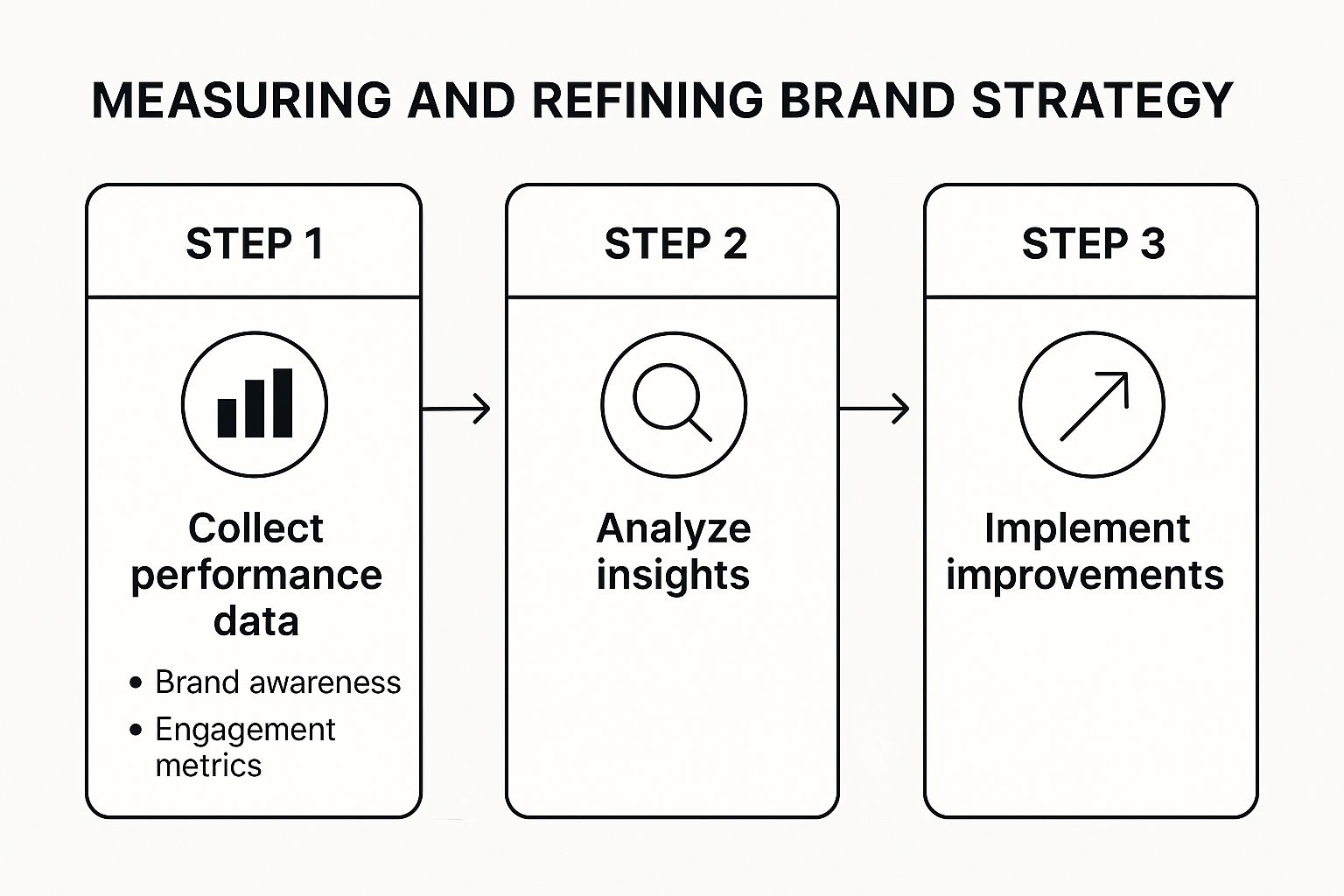Understanding What Makes a Brand Strategy Actually Work

Let's get real about what a brand strategy is. It’s not just a cool logo or a snappy tagline—those are the accessories. The real strategy is the personality underneath, the core of who you are that guides every single decision your business makes. So many entrepreneurs think branding is just visual design, a mistake that quietly loses them customers every day. A solid brand strategy is a psychological blueprint, built to create a genuine, lasting connection with your audience.
This connection isn't always logical. It's the reason someone will pay a premium for a coffee with a mermaid logo or pick a specific sneaker brand that makes them feel like a pro athlete, even if they’re just running errands. To get the full picture, it helps to see how brand strategy fits into a broader marketing strategy. Ultimately, the goal is to weave your business into your customers' lives in a way that matters, turning a simple purchase into a trusted relationship.
Why Emotional Connection Is Your Greatest Asset
The brands that truly win do so on an emotional level. They don’t just sell a product; they sell a feeling, a status, or a sense of community. This emotional bond is the secret sauce that turns first-time buyers into lifelong fans. When a brand reflects a customer's own values and goals, it creates a pull that a list of features or a low price just can't match.
And this isn't just a hunch; the data backs it up. A recent study found that 62% of consumers feel an emotional connection to the brands they buy from regularly. This feeling is a huge loyalty driver, as 80% of global consumers say loyalty is simply buying from the same brand repeatedly. The connection can even be with a company's leadership—70% of consumers feel more connected to brands whose CEOs are active and authentic on social media. The lesson here is clear: people connect with people, so your brand needs to feel human. You can dig into more branding stats by reading the full research on consumer behavior.
Assessing Your Position with Brutal Honesty
Before you can build something strong, you have to know what ground you’re standing on. This means taking a moment for some uncomfortable honesty. How do people really see your business right now? Set aside your mission statement and think about what the market actually perceives.
- Are you the budget-friendly choice, the premium expert, or just another business in a crowded field?
- What specific problems do you solve that your competitors seem to miss?
- If your brand vanished tomorrow, would anyone genuinely miss it? Why?
Answering these questions without letting your ego get in the way is the first real step. It helps you find the gaps between where you are and where you want to be. Your best brand strategy lives in closing that gap—by intentionally shaping how people see you, building emotional value, and creating a brand that people don't just buy from, but truly believe in. This is how you go from being just another option to a brand that customers actively seek out.
Discovering Your Brand's Authentic Foundation
Before you even think about a logo or a catchy tagline, the real work of building a brand begins by looking inward. It’s about digging past surface-level words like "quality" or "innovative" to find the genuine heart of your business. This isn’t just some feel-good exercise; this core foundation becomes the filter for every decision you make, from the products you create to the way you answer customer emails.
Think of it this way: your brand is like a person. What are its unshakeable beliefs? What gets it fired up? What promises can it honestly make and keep? This isn't about guessing what your customers want to hear, but about what’s true to your business’s DNA. An authentic foundation connects on a much deeper level, building the kind of trust that turns first-time buyers into lifelong fans. For more on this, check out our guide on building a strong brand that lasts.
Turning Abstract Ideas into Concrete Differentiators
Claiming you offer "high-quality" service is pretty meaningless on its own—everyone says that. The trick is to show what "high-quality" actually looks and feels like to a customer.
- Does it mean you answer every customer support ticket within 60 minutes?
- Does it mean your handmade scarves use a specific, sustainably-sourced wool that no one else has access to?
- Does it mean your software has a 99.9% uptime guarantee, so your clients never have to worry?
For example, a local coffee shop's brand isn't just about having the "best coffee." It's about its direct-trade partnership with a specific farm in Colombia, sharing the farmers' stories on social media, and hosting weekly free tasting events. That story and experience become their unique selling point, turning a generic claim into something people can actually connect with.
Finding Your Unique Place in the Market
Looking at your competitors is essential, but not so you can copy them. The goal is to perform an honest competitor analysis to spot the gaps they've left open. Where are they falling short? What customer needs are they ignoring? These gaps are your opportunities.
Grab a notebook or open a spreadsheet and map this out. List your top three competitors. For each one, jot down their main message, who they seem to be talking to, and what you see as their biggest weakness. Maybe one competitor is super affordable but has terrible customer service. Perhaps another is a premium brand that feels too stuffy and unapproachable for newcomers.
Your most powerful position often lies where what you do best meets what your competitors do poorly. Your brand's authentic foundation is the story only you can tell, and finding it is the first critical step toward building a strategy that truly resonates.
Building Unshakeable Trust Through Brand Consistency

Trust isn’t a one-and-done deal. It’s built over time, through countless small, consistent moments. Think of every email, social media comment, and product you ship as a small promise. Each interaction either reinforces your brand’s integrity or starts to unravel it. Once you’ve figured out what your brand truly stands for, the next step is to make sure people see it and feel it everywhere they connect with you. This is where consistency becomes your secret weapon for building real, lasting trust.
And it’s more important than ever. For today's customers, trust is a dealbreaker. A massive 81% of consumers say they have to trust a brand before they'll even think about buying from it. This is why you see companies dedicating 10% to 20% of their marketing budgets just to branding. They know every consistent message and positive experience is an investment in their customers' confidence. To see more on this, you can discover more insights on consumer trust statistics.
To help you visualize how different efforts translate into results, we've put together a table comparing various trust-building elements. It breaks down the difficulty, time commitment, and potential business impact for each.
| Trust-Building Element | Implementation Difficulty | Time to See Results | Business Impact | Investment Required |
|---|---|---|---|---|
| Consistent Visuals (Logo, Colors) | Low | Short (Weeks) | High – Immediate brand recognition | Low to Moderate (Design work) |
| Unified Brand Voice & Tone | Moderate | Medium (Months) | High – Builds personality & connection | Moderate (Training, content creation) |
| Transparent Pricing & Policies | Low | Short (Weeks) | Very High – Reduces friction, builds confidence | Low (Internal decision-making) |
| Customer Reviews & Testimonials | Moderate | Medium (Ongoing) | Very High – Social proof is powerful | Moderate (Review platforms, outreach) |
| Responsive Customer Support | High | Immediate (Per interaction) | Very High – Turns problems into loyalty | High (Staffing, training, tools) |
| High-Quality Content (Blog, Social) | High | Long (6+ Months) | High – Establishes authority & expertise | High (Time, creation costs) |
As the table shows, some of the most impactful actions, like transparent policies, require more internal alignment than a huge budget. Others, like building a content engine, are a longer-term play but are essential for establishing true authority in your field.
Maintaining Coherence Across Every Touchpoint
Brand consistency is so much more than plastering your logo everywhere. It’s about creating an experience that feels seamless and predictable. Imagine if your brand is funny and casual on Instagram, but your customer service emails are robotic and stiff. It creates a weird disconnect, right? That little crack of inconsistency makes your brand feel less genuine and, frankly, less trustworthy.
To prevent this, you need to map out every single place a customer might interact with you. Here are a few to get you started:
- Your website copy and overall design
- Social media profiles and day-to-day posts
- Email newsletters and automated messages
- Product packaging and the unboxing experience
- Customer support chats, emails, and phone calls
- Even your invoices and billing communications
For each one, just ask: "Does this look, sound, and feel like us?" Taking the time to do this audit helps you find and fix those jarring moments before they can harm your reputation. If you're running a smaller operation, looking into dedicated branding services for small businesses can give you a framework to keep everything aligned as you scale.
Empowering Your Team to Be Brand Champions
Your brand strategy is only as strong as the people bringing it to life every day. It's almost impossible to maintain consistency if your own team isn't on board or doesn't feel empowered to act on the brand's behalf. If your brand promise is "radical transparency," but a support agent doesn't know what that means in a tough conversation, the promise is broken.
This is why clear, easy-to-use brand guidelines are a game-changer. And they aren't just for your designer. They should guide everyone, from the person packing orders to the one answering sales calls. For instance, a freelance graphic designer who always uses a friendly, collaborative tone in their emails is living their brand as an approachable partner.
True consistency happens when every team member understands the brand's core values and feels empowered to bring them to life in their own role. This turns every interaction into another brick in that foundation of trust you're working so hard to build.
Crafting Your Brand Voice and Visual Identity
If your brand's core beliefs are its foundation, then its voice and visuals are how it shows up in the world. This is the personality that comes through in every Instagram comment, sales pitch, and even the tiny details on your packaging. It’s not just about looking pretty; it’s about strategically showing people who you are. A solid brand strategy turns your core values into tangible sights and sounds that click with your ideal customer.
Think of it like this: your brand voice is what you say and how you say it. Your visual identity is how you look while you're saying it. Both need to be in sync to create a unified and memorable experience for everyone who interacts with your brand.
Defining Your Brand's Unmistakable Voice
Your brand voice isn't just a list of words like "friendly" or "professional." It’s a real-world guide for how your brand communicates. Does it use a bit of humor? Is it more educational and authoritative? Does it talk in short, punchy sentences or long, flowing ones? A great way to get this on paper is to create a simple "This, Not That" chart.
| Brand Voice Attribute | We Sound Like This… | We Don't Sound Like This… |
|---|---|---|
| Confident | "Our process delivers results. Here's how." | "We think our process might help you." |
| Witty | "Finally, a Monday that doesn't feel like a Monday." | "We hope you have a great week." |
| Empathetic | "We know launching a business is tough. We're here to help." | "Our services solve business challenges." |
This voice has to feel authentic to you and your team, and it needs to resonate with your customers. As you develop this voice, it's helpful to understand the different ways you might write for your business. Knowing the difference between copywriting vs content writing helps you make sure your message always fits the situation, whether it's a persuasive sales page or a helpful blog post.
Building a Strategic Visual Identity
Your visual identity—the logo, colors, fonts, and images you use—is your brand’s first handshake. Some studies show that color alone can boost brand recognition by up to 80%. This isn’t about picking your favorite color; it's about using psychology to stir the right emotions. Blue often suggests trust and reliability (think of banks and tech companies), while yellow can project optimism and energy.
Your choices in typography and imagery are just as important. A clean, modern sans-serif font can communicate simplicity and efficiency, while a classic serif font might feel more traditional and established. The photos you choose—whether they’re professional product shots or real-life user-generated content—tell a story about who uses your brand and what it means to them.
The goal is to build a consistent visual language that people recognize instantly. This consistency across every platform, from your website to your social media, builds familiarity and trust. Writing these choices down is a must. For a practical way to organize all these elements, our detailed brand style guide template is a fantastic starting point. It helps ensure everyone on your team presents the brand in the same way, strengthening your entire brand-building effort.
Implementing Your Brand Strategy Across Modern Channels

You’ve done the hard work: your brand’s foundation, voice, and look are locked in. Now it’s time to bring it to life where your customers actually hang out. Activating your brand isn't about shouting from every rooftop; it's about showing up consistently on the platforms that matter most to your audience. This is the moment your strategy stops being an internal document and becomes a living, breathing part of your business.
The goal is to use today's tools and trends to create meaningful connections without getting sidetracked by every new, shiny app. It's about finding that sweet spot between efficient tech and a real human touch to create an experience that feels personal and genuine. This balance is what builds a brand that doesn’t just get noticed but earns real loyalty. For new businesses just starting, our guide on effective startup marketing strategies is a great read for getting your first steps right.
Mastering Meaningful Personalization
Personalization is way more than just dropping a customer’s first name into an email. Today, it’s about creating experiences that feel like they were made just for one person, based on their specific tastes and actions. This is where your brand strategy meets the real world. Brands that are getting it right use data to deliver super-customized interactions that make people feel seen. Think of Spotify’s yearly "Wrapped" campaign—it turns your listening habits into a fun, shareable story. Or Nike By You, which lets you design your own sneakers. These examples show how hyper-personalization can forge memorable interactions that build deep engagement. To see what's on the horizon, you can explore brand design predictions for the coming years.
This might sound like a job for a huge company with a massive tech budget, but you can start small. Here are a few ideas:
- Segment your email list to send special offers based on what people have bought before.
- Run polls on social media and let your followers vote on your next product or blog post.
- Remember a previous chat with a customer and bring it up the next time you talk.
These little personal touches show you’re paying attention, and that’s what really matters.
Building a Genuine Community Around Your Brand
A strong brand doesn’t just have customers—it has a tribe of advocates. Building this community is one of the best things you can do to get people talking about you and drive organic growth. It’s all about creating a space, whether that's a Facebook group, a Discord server, or even just a lively comments section on Instagram, where people feel like they belong.
The secret is to make the community less about you and more about them. Start conversations, ask for their thoughts, and celebrate what they share. A skincare brand, for instance, could start a forum where users swap routines and cheer each other on. A local bookstore could run a monthly book club that builds real-life friendships. When you build a genuine community, your brand becomes the facilitator of connections, not just the seller of products. You shift from just making a sale to creating a shared identity.
Measuring Success and Evolving Your Strategy
A strong brand strategy isn't something you create once and then stick in a drawer. Think of it as a living, breathing part of your business that needs to grow and adapt with you. The real measure of your brand isn't just how well it launches, but how it stays relevant and impactful over the long haul. This means moving beyond gut feelings or vanity metrics like follower counts and digging into data that tells you what’s actually connecting with people.
Measuring your brand strategy’s success is all about asking the right questions and being ready to act on what you find. Don’t get bogged down by every single data point. Instead, focus on the metrics that link directly to your business goals. For example, brand equity isn't just about people recognizing your logo; it's about the real value and trust your brand holds in their minds. To see how to track this, check out this guide on key campaign performance metrics that go beyond the surface.
Key Metrics That Truly Matter
To get a clear picture of how your brand strategy is performing, you need to look at a few different areas. Relying on a single metric can give you a skewed view. The right metrics often depend on where your business is in its journey, but they generally fall into a few important buckets.
To help you decide what to track, I've put together a table that shows which metrics are most useful at different stages of business growth.
Brand Strategy Metrics Comparison
Key performance indicators for measuring brand strategy success across different business stages
| Metric Category | Early Stage Focus | Growth Stage Focus | Mature Stage Focus | Measurement Frequency |
|---|---|---|---|---|
| Awareness & Recall | Website Traffic, Social Mentions | Aided & Unaided Brand Recall Surveys | Share of Voice vs. Competitors | Quarterly |
| Engagement | Social Media Engagement Rate, Comments | Customer-Generated Content, Community Activity | Net Promoter Score (NPS), Repeat Purchase Rate | Monthly |
| Perception | Customer Feedback, Social Media Sentiment | Focus Groups, Online Reviews Analysis | Brand Association Surveys | Semi-Annually |
| Conversion | Lead Generation from Branded Content | Social Commerce Sales, Assisted Conversions | Customer Lifetime Value (CLV) | Monthly |
An early-stage creative, for instance, might obsess over their social media engagement rate to confirm their brand voice is resonating. In contrast, a more established business might focus on their share of voice to see how they're performing against competitors. This table gives you a starting point for building your own brand dashboard.
Evolving Without Losing Your Core
Collecting data is only the first part. Knowing when and how to respond to it is what separates good brands from great ones. Markets change, customer tastes shift, and new opportunities pop up. The secret is to evolve your tactics without abandoning your core identity.
For example, if you keep hearing from customers that they're confused about what you offer, it might be time to refine your messaging—not a signal to tear down your entire brand and start over. If your target audience suddenly flocks to a new social platform, it's a smart move to experiment there as an evolution of your channel strategy.
To make informed changes, you can use tools that help you look ahead. Exploring predictive analytics for marketing can help you forecast how certain changes might play out, allowing you to make proactive decisions instead of just reacting to problems. Ultimately, a successful brand strategy is a continuous loop of implementing, measuring, and refining, ensuring your brand remains a powerful asset that drives your business forward.
Your Brand Strategy Implementation Roadmap
So, you’ve put in the hard work to define your brand’s core foundation, voice, and visual style. That’s a huge step, but now it's time to put all those ideas into practice. This is where your implementation roadmap comes in—it’s the action plan that turns your strategy from a document into a living, breathing part of your business. This isn't just about launching a new logo; it's about weaving your brand into every customer interaction and daily operation. A solid plan helps you focus on what matters most, use your resources wisely, and avoid the common traps that kill momentum.
Think of this as the start of ongoing brand management. It’s not a one-and-done launch. It's about consistently overseeing your brand's image to make sure it always lines up with your core strategy. To get a feel for the bigger picture, you can check out the foundational concepts of brand management and see how this all fits together.
Get Your House in Order: Internal Alignment and Asset Creation
Before you show your new brand to the world, you need to make sure your own team is on board. Seriously, some of the biggest branding mistakes happen when a company’s team isn’t aligned with the message they’re trying to send. Your employees are your first and most important brand ambassadors.
- Bring Your Team Up to Speed: Host a workshop or a casual meeting to walk everyone through the new brand strategy. Don't just show them the new colors; explain the why behind it all—the mission, the values, and the ideal customer you're trying to reach. Everyone, from customer service to sales, should understand the brand voice well enough to use it naturally.
- Create Your Core Brand Tools: Now’s the time to create or update the tangible pieces of your brand. This means finalizing your logo suite, color palette, and typography. Pull it all together in a comprehensive brand style guide. This guide will be your bible for keeping everything consistent.
- Update Every Single Touchpoint: Do a full audit of all your existing materials. This is where the details matter. Update your website, email signatures, social media profiles, business cards, and any sales or marketing collateral. Consistency here is key to building trust.
This first stage is all about building a strong, unified front from the inside out. When your team genuinely understands and believes in the brand, they'll naturally project that same confidence and clarity to your customers.
The Big Reveal: Your Strategic Launch
Once your team is aligned and your assets are ready, it's go-time. A launch isn't just a single event; it's a coordinated campaign designed to make a memorable first impression (or re-introduction). The goal here is to build some buzz and clearly communicate what your brand now stands for.
Start by picking your main launch channels—the platforms where your target audience actually hangs out. You don't need to be everywhere at once. Focus your energy on two or three key channels to make a bigger splash. Create a content calendar just for the launch period, with posts that tell the story of your brand's evolution. This is your chance to explain the "why" to your audience, turning them from casual followers into true fans.
Keep the Momentum: Ongoing Measurement and Tweaks
A great brand strategy is never really "done." It’s a continuous loop of doing, measuring, and refining. Your launch will give you a ton of data about what connects with your audience and what falls flat. This feedback is pure gold.
This infographic shows a simple cycle for keeping your brand strategy fresh: gather data, find insights, and make improvements.

As the visual shows, brand building is a cycle, not a one-off project. Set up systems to track key metrics like brand awareness (think social media mentions or direct website traffic) and customer sentiment. Regularly check this data to see how your brand is being perceived out in the wild. You can use surveys, social listening tools, or just ask for direct customer feedback to get the full story. This ongoing analysis lets you make smart adjustments, ensuring your brand stays relevant and connected as your business grows.
Ready to bring your brand strategy to life? At Creativize, we connect you with talented local professionals who specialize in everything from brand design to messaging. Find the perfect creative partner to help you build and implement a brand that truly stands out. Explore creative talent on Creativize today.

